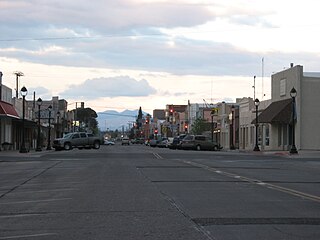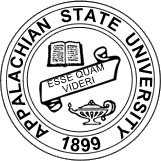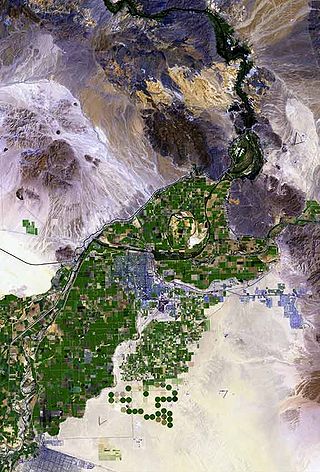
Graham County is a county in the southeastern part of the U.S. state of Arizona. As of the 2020 census, the population was 38,533, making it the third-least populous county in Arizona. The county seat is Safford.

Safford is a city in Graham County, Arizona, United States. According to the 2020 Census, the population of the city is 10,129. The city is the county seat of Graham County.

Thatcher is a town in Graham County, Arizona, United States. According to the 2010 Census, the population of the town is 4,865. It is part of the Safford Micropolitan Statistical Area.

Hobbs is a city in Lea County, New Mexico, United States. Its population was 40,508 at the 2020 census, increasing from 34,122 in 2010.

Appalachian State University is a public university in Boone, North Carolina. It was founded as a teachers college in 1899 by brothers B. B. and D. D. Dougherty and the latter's wife, Lillie Shull Dougherty. The university expanded to include other programs in 1967 and joined the University of North Carolina System in 1971.

The University of Louisville (UofL) is a public research university in Louisville, Kentucky. It is part of the Kentucky state university system. When founded in 1798, it was one of the first city-owned public colleges in the United States and one of the first universities chartered west of the Allegheny Mountains. The university is mandated by the Kentucky General Assembly to be a "Preeminent Metropolitan Research University". It enrolls students from 118 of 120 Kentucky counties, all 50 U.S. states, and 116 countries around the world.

The State University of New York at Buffalo, commonly called the University at Buffalo (UB) and sometimes called SUNY Buffalo, is a public research university with campuses in Buffalo and Amherst, New York, United States. The university was founded in 1846 as a private medical college and merged with the State University of New York system in 1962. As of 2022, it is one of two flagship institutions of the SUNY system, along with Stony Brook University. As of fall 2020, the university enrolled 32,347 students in 13 schools and colleges, making it the largest public university in the state of New York.

The University of Baltimore is a public university in Baltimore, Maryland. It is part of the University System of Maryland. UBalt's schools and colleges provide education in business, law, public affairs, and the applied arts and sciences. The university is the location of one of Maryland's two law schools.

Northern Arizona University (NAU) is a public research university based in Flagstaff, Arizona. Founded in 1899, it was the final university established in the Arizona Territory.

Northern Illinois University (NIU) is a public research university in DeKalb, Illinois. It was founded as Northern Illinois State Normal School in 1895 by Illinois Governor John P. Altgeld to provide the state with college-educated teachers. In addition to the main campus in DeKalb, it has satellite centers in Chicago, Naperville, Rockford, and Oregon, Illinois.

Eastern Illinois University (EIU) is a public university in Charleston, Illinois. Established in 1895 as the Eastern Illinois State Normal School, a teacher's college offering a two-year degree, Eastern Illinois University gradually expanded into a comprehensive university with a broad curriculum, including bachelor's and master's degrees in education, business, arts, sciences, and humanities.

Mesa Community College (MCC) is a public community college in Mesa, Arizona. It is the largest of the 10 community colleges in the Maricopa County Community College District, the largest community college district in the United States in terms of enrollment.

Concord University is a public university in Athens, West Virginia. It was founded on February 28, 1872, when the West Virginia Legislature passed "an Act to locate a Branch State Normal School, in the town of Concord Church, in the County of Mercer". This normal school was founded by veterans of both the Union and the Confederacy, Concord is named for the ideal of "harmony and sweet fellowship".

Texas A&M University–Kingsville is a public research university in Kingsville, Texas. It is the southernmost campus of the Texas A&M University System. The university developed the nation's first doctoral degree in bilingual education. It is classified among "R2: Doctoral Universities – High research activity" and accredited by the Southern Association of Colleges and Schools (SACS).

Safford High School, of the Safford Unified School District, is one of two public high schools in Safford, Arizona. The campus hosts the Safford Center for the Arts, located on the north lot of the campus property.

The Gila River Valley is a multi-sectioned valley of the Gila River, located primarily in Arizona. The Gila River forms in western New Mexico and flows west across southeastern, south-central, and southwestern Arizona; it changes directions as it progresses across the state, and defines specific areas and valleys. The central portion of the river flows through the southern Phoenix valley region, and the final sections in southwestern Arizona form smaller, irrigated valleys, such as Dome Valley, Mohawk Valley, and Hyder Valley.

Central is a census-designated place in Graham County, Arizona, United States. Its population was 758 as of the 2020 census. It is part of the Safford micropolitan area.

The Gila Valley Arizona Temple is a temple of the Church of Jesus Christ of Latter-day Saints in the town of Central between the communities of Pima and Thatcher in Arizona. The temple was dedicated on May 23, 2010, following an open house lasting from April 23 to May 15.

Gila Community College (GCC) is the community college serving the Gila Community College District in Gila County, Arizona. It has two campuses:
- Gila Pueblo Campus, Globe, Arizona
- Payson Campus, Payson, Arizona



















